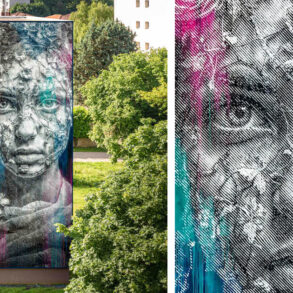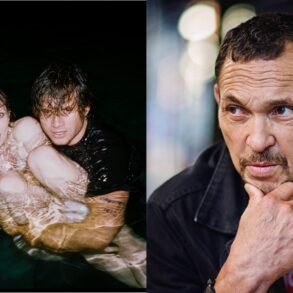He’s the most celebrated, popular, well-known and loved artist in the country – we don’t know who he is but we do know that he comes from Bristol. It was time to explore the existing pieces that are splattered around the city centre.
My guide for the morning is a bit of a Bristol institution/legend himself, John Nation. There’s little this man doesn’t know about the culture/art/graffiti/music that has emanated from Barton Hill and the like over the last 40 years, and now he’s a tour guide distributing his knowledge of Bristol street art.
We met up outside College Green and our first stop is just across the road at the bottom of Park Street to find Well Hung Lover.
Painted in the summer of 2006, illegally, of course, the work uses stencils that allows the artist to execute the art and then remove themselves quickly. Scaffolding is put up the day before, Banksy arrives at 7.00am with an accomplice, his eyes and ears, he climbs the structure with a case containing spray paint, mask, gloves and the pre-prepared design stencils; forty minutes later, the deed is done and he is driven off.
John said: ‘The location was specifically selected because directly opposite is Bristol City Hall and over many decades they’ve had engagements with graffiti culture in Bristol, in particular Banksy and the removal of his artwork. Once the work is exposed then you have the speculation, the mystique and the intrigue by the local media, bloggers, street art enthusiasts, the general public – is this a Banksy? Within 24 hours of this being confirmed on his website, city council have a decision to make. Painting anybody’s property is criminal damage, Banksy or whoever. This is a watershed moment in Bristol, the city council, knowing the global standing of Banksy, have a decision to make. They decided to leave its fate to the citizens of Bristol, they organized an online poll, should it be allowed to remain? 97% said they wanted it to stay. That was a huge endorsement of the popularity of the artist. He’s Marmite for many people, they love it or hate it. A criminal or artistic genius? It was allowed to remain.’ That said, it has been vandalised itself over the years, perhaps student pranks, perhaps other graffiti artists accusing him of selling out or brandalism.
From here it’s up Park Street to the City Museum.

This was the scene for the 2009 exhibition entitled Banksy vs The Bristol Museum which attracted 400,000 visitors, generated £20 million for the local economy and displayed 80 new works of which only one remains in the building, Paint-Pot Angel.
This is a figurine of an angel with a pot on its head and pink paint dripping down the side. Just by it at the exhibition was the huge canvas oil painting Monkey Parliament with the politicians portrayed as chimpanzees, this was then sold for half a million, lent back to the museum during the Brexit referendum and sold again for £12 million. Not the most expensive though, that was the infamous shredded Love is in the Bin that went for nearly £20 million.
So, what do we know about Banksy?
Born in Bristol, possibly Yate. 1974ish. Possibly Robin Banks (geddit). Maybe Robbie. As we head back down Park Street, John claims that the identity of Banksy is Bristol’s worst kept secret. John has met him but would never divulge.
We pass close by to the Bristol Cathedral Choir School (middle class?), apparently that is where Banksy gained his education, the teachers know but won’t tell. There is a school photograph that includes a boy with ginger hair and glasses, apparently that is him.


Originally painted in 2003, this one has an intriguing history as it was first created on the side of Thekla, the boat/music venue that is moored in Bristol harbour. John said: ‘It is an image that after many years of water damage to the original piece, it was decided by the owners of the Thekla to have it removed and then because of the legacy of Banksy and culture in Bristol they felt it needed to be preserved and they gifted it to Bristol Museum which means that it will forever be in the archives. This can never fall into the hands of a private collector. Never.’
The boat had to be taken into dry dock and what you see are the actual bits of sheet metal that were removed. As John observed, though, it does raise two interesting questions about significant street art. Should it be outside where it was first created or should it be protected and preserved inside where it can inspire younger generations to respect both art and museums? And in terms of finesse does street art escape the rules of fine art because of the urgency and drama of the moment of creation? Discuss.

It is a homage to, or a parody of, the painting by Dutch artist Johannes Vermeer entitled Girl with a Pearl Earring. Instead of the earring, Banksy has used the AVT alarm box as the eardrum. John explains that what he likes about it is that it is a classic image with a subverted twist – he’s saying that wherever you live you will hear alarms going off. The stencilled painting was created in October 2014, within 24 hours of being discovered it had been vandalised with black paint. A fence has only recently been installed to prevent people getting close. In 2020, during the pandemic, a cloth face mask was placed over the girl. If you look to the bottom left of the mural, you’ll find a work by the artist ‘Banksy Hates Me’ of a young girl. This is dated 2023 and in fact the artist is a big fan of Banksy, protecting a piece by the Bristol man located in New Orleans, and it is in turn a kind of homage.
Finally, it’s back to the city centre and up Stokes Croft from the large St James Barton roundabout.
Stokes Croft is street art city, wild colours and images abound on every side, like a free canvas – John expressed concern about what might happen as the area becomes gentrified.

Banksy’s The Mild Mild West is on the right side, on No.80. Painted in 1999, it is just one of two freehand pre-millennium works that have survived. The image is of a teddy bear with a Molotov cocktail facing three policemen, the bear representing the people of Bristol, rising up and fighting against oppression – the laidback Bristolian taking on commercialization and government. The painting has no protection and the building has just been sold, so who knows for its future. John said: ‘It’s an alternative welcome to Bristol – a great piece, my favourite Banksy work ever.’
The walk takes over two hours and all that time John has been extolling the virtues of Bristol street art culture, that and the dangers of conspiring to vandalise.
Contact 07748 632663 for The Bristol Street Art Tour
This post was originally published on this site be sure to check out more of their content.








